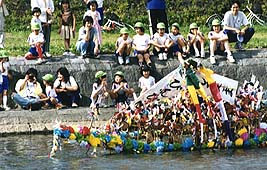田植えも終わった旧暦五月、大曲周辺では鹿島流しが行なわれた。鹿島大明神の旗を立てた武者人形にお膳を備え、「おやき」と呼ばれる餅と路銀の十文銭を背負わせて船に乗せ、諏訪神社で御祈祷を受けたあと、丸子川に流すというもので、すでに300年以上続いている伝統行事である。ひとびとの罪や穢れを人形に託して浄める、「禊ぎ祓え(みそぎはらえ)」のヴァリエーションのひとつであろう。
大曲、花館、大川西根、藤木、飯田などの集落で行なわれているが、地域によって鹿島の形に特徴があり、また流す日も異なる。
 大曲小学校三年生による鹿島流し(丸子川)
大曲小学校三年生による鹿島流し(丸子川) 大曲の花火
Fireworks Display in Omagari
いまや全国にその名を知られるようになった大曲の花火大会は、毎年8月の第四土曜日、大曲大橋下流の雄物川河畔で開催される。全国から選抜された花火師30数名が参加して技を
競い、50万余の大観衆を魅了する。
明治43年(1910)から始まり、戦時中に一時中断はあったものの、平成12年には74回目を迎え、いまや「伝統的行事」になった。大曲の花火大会の特徴は、じっさいに製作した花火師が、自らその作品を打ち上げるという点にある。また、これまでの花火の概念を打ち破った「創造花火」部門の開設は、アートとしての花火の可能性を開いた画期的な出来事であった。
阿国歌舞伎の昔から、さまざまな芸能を育んだ河原という異空間は、いまや夜空を彩る華麗な花火によって、より開放的な空間へとショーアップされたのである。
また、アイディアや演出にさまざまな工夫を凝らした大曲の花火は、海外公演でも絶大な人 気を博し、国際交流のうえでも大きな役割を果たしている。
The fireworks display in Omagari, which has recently become
nationally famous, is held on the bank of the Omono-gawa River on the fourth
Saturday of August every year. More than thirty pyrotechnists, invited from
various parts of Japan, demonstrate their skills and fascinate over 500,000
spectators. The breathtaking view of elaborately designed new, creative fireworks
as well as traditional fireworks has enjoyed great foreign popularity. The
fireworks play a big part in cultural exchanges with foreign countries.
川
と
ま
つ
り
と
ま
つ
り